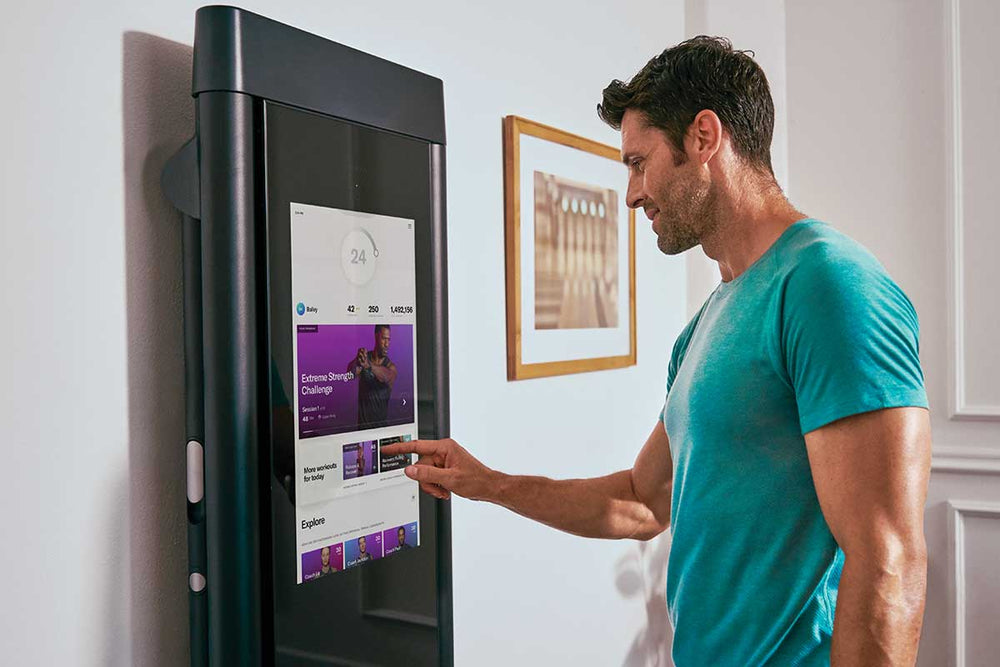Tonal’s Active Recovery features help you dial back the intensity now so you can see big gains later.
Active recovery is an essential part of any effective training program. That’s why Tonal offers Active Recovery features that will help you maintain your momentum (and your Strength Score) without overtraining. “The goal is to shift your mindset to ‘What can I do to continue to improve even if I’m fatigued?’” says Christian Hartford, Senior Performance Manager of Applied Sports Science at Tonal. “And chances are, you’re going to come out of an active recovery workout feeling better.”
What Is Active Recovery?
Active recovery is defined as low-intensity exercise following a more strenuous effort. If you’re normally lifting heavy weights, an active recovery workout might involve bodyweight exercises or lifting at a reduced weight.
What Are the Benefits of Active Recovery?
Gentle movement promotes blood flow to sore muscles, which aids in lymphatic drainage of excess inflammatory byproducts of exercise. Reducing inflammation alleviates sore and tight muscles and primes them for your next big effort. That means more progress, gains, and Power PRs in the long run.
Why Is Active Recovery Better than Passive Recovery?
There’s nothing wrong with taking a complete break from exercise on occasion. For example, if you’re recovering from a bone, muscle, or joint injury or an illness (like Covid-19), your body will likely benefit most from taking time to heal. In those cases, exercising too soon could actually set you back, so don’t feel guilty about spending more time on the couch.
However, if you’re otherwise healthy but just feeling a little post-exercise soreness, active recovery is your best bet for loosening up and getting ready to crush your next workout. By strategically using light movement instead of complete rest on recovery days, you can bounce back from heavy training bouts stronger than before.
3 Ways to Incorporate Active Recovery on Tonal
1. Do the Same Workout With Less Weight
Skipping a sweat session when you feel sore or fatigued might actually stall your progress. Now instead of opting out, you can toggle on the Recovery Weight feature before any Guided or Custom workout to reduce the weight to around 50 to 60 percent of your one-rep max for all exercises.

This research-backed recommendation is consistent with what professional and collegiate sport coaches use for deload training, a common strength and conditioning practice during which you intentionally reduce the overall load placed on your body. The best part? Using the Recovery Weight feature won’t negatively impact your Strength Score.
When you should use this feature depends on how ready you are for your workout, both physically and mentally. A lighter load workout is ideal to do between heavy-load programs, if you didn’t sleep well, or if you’re feeling really stressed or sore. But resist the urge to toggle it on for every workout. Your body adapts to the stress you put on it, so active recovery is the perfect complement to those challenging muscle-building workouts.
2. Take Coach-led Active Recovery Workouts
If you really want to focus on movement quality over quantity, check out Active Recovery classes, specially programmed with recovery moves. These classes give you the ability to work out with your favorite Tonal coaches for a lighter workout instead of taking a rest day. “They’ll feel a little less demanding with a slower pace and a reduced intensity so you can fit in a workout even when you’re not feeling 100 percent,” explains John Christie, Director of Curriculum at Tonal.
You can expect shorter warmups so that you can jump right into a rejuvenating workout without the normal prep needed before an intense session. The lifts in each Recovery Workout class will automatically be set to around 50 to 60 percent of your one-rep max.
These workouts also help you improve your range of motion with added mobility and stability, which research shows offer major boons for strength over time.
Active Recovery workouts are a great opportunity to focus on improving movement patterns and movement quality by encouraging muscle memory for when you are pushing heavier weight. Form Feedback and Smart View cues are your secret weapon here.
Try one of these active recovery workouts the next time you’re feeling sore:
Lower-Body Recovery – Coach Tim Landicho
Squats and lunges might sound like the last thing you want to do if you’re sore from heavy lower-body lifting, but in this workout, you’ll do all the exercises with reduced resistance or just your body weight to help loosen up achy muscles. You’ll also practice deep stretches to aid in recovering tired muscles.
Just Enough Active Recovery – Coach Ash Wilking
Ideal for the day after a tough full-body workout, this session includes squatting, hinging, pushing, and pulling movements, all done at a reduced weight. You’ll finish feeling refreshed and limber.
Full-Body Deload – Coach Kristina Centenari
Restore blood flow to stiff muscles with a combination of on-Tonal moves and off-Tonal stretches in this full-body recovery session. Putting in the work at a lower intensity will prep you for your next challenging workout.
3. Tailor Your Workouts Based on Muscle Readiness
You’ll now find your muscle readiness avatar showing you which muscle groups are fresh, recovering, and fatigued based on your recent workouts in more places. In addition to the filter on the Explore page, you can now view your avatar before you start a workout and on the home screen of the mobile app.
“Muscle Readiness is a useful tool that objectively illustrates how a Tonal athlete might feel on any given day,” says Hartford. “You may wake up and feel your quads are super sore from a workout a day or two days before that. With Muscle Readiness, you can confirm those feelings with the objective visual based on how much you’ve been loading that muscle group.”
The Muscle Readiness feature is based on your total volume of load on that muscle group over the course of the previous four days. For example, if you worked out three times in the past four days and two of those workouts included lower body with emphasis on the quads, you’ll see your avatar’s quads highlighted in light blue (still recovering) or red (fatigued) on the home screen.

A muscle group is considered “fresh” when you’ve completed approximately five sets or less, and “recovering” when you perform between five to 10 sets of exercises in the last four days. Once you’ve hit more than 10 sets for a muscle group, the muscle group goes into the fatigued zone indicating more recovery is needed.
You can use Muscle Readiness as a guide: Either work on a different muscle group or, if you still want to hit that muscle group, take it easier with the Recovery Weight toggle or opt for an Active Recovery class. Once the muscle group is fresh again, it’s time to get back to it. While Muscle Readiness gives you a snapshot of the past four days, research shows you should complete 10 to 20 sets per week per muscle group to build muscle and achieve strength goals.



